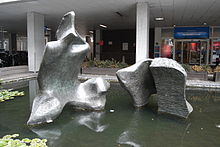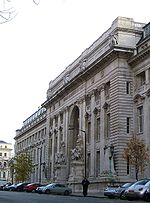- Charing Cross Hospital
-
Charing Cross Hospital Imperial College Healthcare NHS Trust Geography Location Hammersmith, London, England, United Kingdom Coordinates TQ237780 Organisation Care system Public NHS Hospital type Teaching Affiliated university Imperial College London Services Emergency department Yes (Serious injuries centre for West London) Beds 511 History Founded 1818 (as the West London Infirmary, renamed Charing Cross in 1827) Links Website http://www.imperial.nhs.uk/charingcross Lists Hospitals in England Charing Cross Hospital is a general, acute hospital located in London, United Kingdom and established in 1818. It is located several miles to the west of the city centre in the London Borough of Hammersmith and Fulham.
It is part of Imperial College Healthcare NHS Trust and is one of the Imperial College School of Medicine's teaching hospitals. It is a tertiary referral centre for neurosurgery, and is a national centre of excellence for gestational trophoblastic disease. It currently houses the serious injuries centre for West London.[1]
The hospital is host to the Kennedy Institute of Rheumatology and the West London Neuroscience centre. Additionally, there is a recently added day surgery unit, the Riverside Wing. The West London Mental Health NHS Trust also has buildings on site.[2] The hospital hosts the largest and oldest gender identity clinic in the country, with 150 operations performed annually.[3]
Contents
History
19th century
Charing Cross Hospital was started as the 'West London Infirmary and Dispensary' in 1818 at 16 Suffolk Street near the Haymarket Theatre by Dr. Benjamin Golding. The hospital was the dream of Dr. Golding who wanted to establish a place of healing for the poor. The then Duke of York was asked to become patron, which he accepted and the hospital was thenceforth known as the Royal West London Infirmary. Following this, the then Duchess of York and Duke of Cambridge became patrons. [4]
In 1821, the institution began to reach capacity, treating nearly 10000 patients a year. A new site was found at 28 Villiers Street, near Charing Cross in the heart of the metropolis. The infirmary provided accommodation for twelve beds. It was shortly after this move that there was a plan put in place to establish a medical school alongside the infirmary. The Charing Cross Hospital Medical School was recognised by the newly founded University of London in 1829, although the school had been training doctors since 1822. Over the following years, the list of benefactors and patrons grew, including many from the Royal Family. [5]
In 1827, the name of the Royal West London Infirmary was changed to Charing Cross Hospital. Plans were drawn up by architect Mr Decimus Burton in 1830 and a site was found in the Strand. On 15th September 1831 the foundation stone was laid by the Duke of Sussex. The first completed ward was named after the daughter of the Duchess of Kent, Princess Victoria, who went on to become Queen Victoria. The principal ward for men was named Golding Ward after the founder. The hospital itself was completed in January 1834, the total cost of the build and furniture coming to £20000. In October 1834, the 22 medical students were transferred from Villiers street to the new building. [6]
The hospital and medical school continued to expand. King's College London opened and wanted a medical school and offered Charing Cross a substantial amount of money for their students to be trained there. Dr Golding was opposed to the idea and after several years of negotiation, King's College decided to open their own hospital in 1839. During these years of negotiation, the school saw difficult times with the number of students enrolled plummeting. However, by 1840 the number of students leapt up and faith in the school was restored. Dr Golding suffered from a stroke in 1840. In 1854, the hospital was flourishing and the top floor of the hosptial (which had been left as an empty carcass) was completed. In 1856, Dr. Golding retired as Director of Charing Cross Hospital Medical School. The hospital began to go through some difficult times, with many newer hospitals opening in close proximity and the establishment of newer, larger medical schools. [7]
However, the institution continued on, 1866 saw the arrival of professional nursing staff and the hospital was expanded several times during the years, with a major rebuild in 1877 seeing the hospital double in size.
20th century
The hospital was further extended in 1902. [8] In 1926, the Royal Westminster Opthalmic Hospital was merged with Charing Cross Hosptial. [9]
After the second World War it was decided that the hospital should move out of central London. Several sites were considered and a large site was found at Northwick Park in Harrow. However, the University of London deemed that they would not be able to remain affiliated with the hospital should it move there and so it was decided to pass this site over to the Ministry of Health who developed it into the present Northwick Park Hospital.[10]
In 1957 a link was proposed with Fulham and West London Hospitals. The proposal was controversial with the residents of Fulham, who wanted their existing hospital redeveloped not taken over. A public meeting was set up with the Mayor of Fulham and the Chairman of the hospital, Lord Inman explained that the decision was made by the Ministry of Health and that the hospital built would be well equipped and provide a full service. This allayed most fears. The new Charing Cross Hospital was opened in 1973 on Fulham Palace Road, on the site of the old Fulham Hospital. This new hospital was built at the then staggering cost of £15 million pounds. A fifteen storey building was bult in the shape of a cross along with several lower story buildings, and three high-rise residential blocks were to be built to house medical staff, nurses and medical students (which are still present: Golding, Parsons and Cliff houses respectively). Despite the move, it retained the Charing Cross name. Initially it was known as 'Charing Cross Hospital, Fulham' but over the years the 'Fulham' part has been dropped. [11]
In recent times, the hospital has pioneered the clinical use of CT scanning.
Notable alumni
Alongside the now famed Dr. Benjamin Golding and the various Royal Patrons involved in the inception of the hospital, there have been several notable alumni of both the hospital and its medical school.
One of the early students of Charing Cross Hospital was Dr. David Livingstone, now remembered as the celebrated African explorer.
The outstanding scientist Dr. Thomas Huxley was another student at the hospital's medical school whose works include 'Zoological Evidences of Man's Place in Nature' and 'Evolution and Ethics'. Huxley was instrumental in the founding of Imperial College London although he was not associated with the merger of the two that would happen almost a century later.
Mr Astley Bloxam, an early and famed Plastic surgeon.
Asthma was extensively described by Dr. Henry Hyde Salter, a physician at this hospital [12]
Dr. Christopher Addison, later Viscount Addison worked at the hospital. He was the son of the discoverer of eponymously named Addison's Disease and he himself is accredited with naming 'Addisons transpyloric plane' a part of the human body used as a surgical landmark. Addison later stood for parliament for the Labour Party and became leader of the House of Lords.
Sir Herbert Waterhouse was a surgeon at the hospital and Sir Gordon Holmes, famed neurologist also worked there.
Imperial College
Originally supporting Charing Cross Hospital Medical School, Charing Cross and Westminster Medical School was formed in 1984 by the merger with Westminster Hospital Medical School. In 1997, CXWMS merged with Imperial College London (whose medical department was at St Mary's Hospital Medical School in Paddington), The National Heart & Lung Institute and the Royal Postgraduate Medical School (at Hammersmith Hospital) to create a large new institution, Imperial College School of Medicine.
Imperial College London use most of the floors of the East Wing lab block, housing academic departments and their labs, 3 lecture theatres on the 8th, 9th and 10th floors, the Pathology museum on the 11th floor and the Dissection rooms on the 14th floor.
The Reynolds Building (originally built for Charing Cross and Westminster Medical School), lies adjacent to the hospital within the campus and is used extensively by Imperial College School of Medicine. It consists of a lecture theatre (Brian Drewe Lecture Theatre), the Campbell-Adamson library and various seminar and teaching rooms. In addition to this, it houses the Reynolds Bar, a centre for the various functions that the Students' Union holds. It also contains a music room, gym and student union shop and offices.
The Glenister building is also located on this campus. It provides additional teaching space for Imperial College London.
On site, there is a sports centre and sports hall as well as Parsons House, one of the Imperial College Halls of Residence.
Maggie's Centre
On 29 April 2008, Maggie's Centre was opened by Nigella Lawson and Sarah Brown. This support centre is available for anyone who is affected by cancer in London.[13] In 2009, the centre was visited by Michelle Obama[14] and in October was given the 2009 Stirling Prize from the Royal Institute of British Architects.[15]
References
- ^ Charing Cross Hospital – NHS Choises
- ^ Charing Cross Hospital – Imperial College Healthcare NHS Trust
- ^ Charing Cross Hospital | Gender Surgery – mperial College Healthcare NHS Trust
- ^ The Two Pillars Of Charing Cross: The Story of a Famous Hospital by RJ Minney. Published by Cassell London 1967.
- ^ The Two Pillars Of Charing Cross: The Story of a Famous Hospital by RJ Minney. Published by Cassell London 1967.
- ^ The Two Pillars Of Charing Cross: The Story of a Famous Hospital by RJ Minney. Published by Cassell London 1967.
- ^ The Two Pillars Of Charing Cross: The Story of a Famous Hospital by RJ Minney. Published by Cassell London 1967.
- ^ The Two Pillars Of Charing Cross: The Story of a Famous Hospital by RJ Minney. Published by Cassell London 1967.
- ^ The Two Pillars Of Charing Cross: The Story of a Famous Hospital by RJ Minney. Published by Cassell London 1967.
- ^ The Two Pillars Of Charing Cross: The Story of a Famous Hospital by RJ Minney. Published by Cassell London 1967.
- ^ The Two Pillars Of Charing Cross: The Story of a Famous Hospital by RJ Minney. Published by Cassell London 1967.
- ^ Henry Hyde Salter (1823-71): a biographical sketch, Thorax. 1985 December; 40(12): 887–888.
- ^ Maggies's Cancer Caring Centres: Maggies's London
- ^ Maggies's Cancer Caring Centres
- ^ Maggie's Centre Wins Stirling Prize – Londonist
External links
- Imperial College Healthcare NHS Trust's official site
- A page about the hospital archives which contains some historical information about the hospital
Imperial College Healthcare NHS Trust Hospitals Charing Cross Hospital · Hammersmith Hospital · Queen Charlotte's and Chelsea Hospital · St Mary's Hospital · Western Eye HospitalNotable people Associated institutions Imperial College London (Imperial College Faculty of Medicine · Imperial College School of Medicine)
 CategoryCategories:
CategoryCategories:- Imperial College Healthcare NHS Trust
- Hospitals in London
- NHS London
- NHS hospitals
- Health in Hammersmith and Fulham
- Buildings and structures in Hammersmith and Fulham
- Teaching hospitals in England
Wikimedia Foundation. 2010.


